This article is in a series designed not to provide ‘A N Other’ opinion about a chef’s output, to be lost in the now sea of increasing ‘noise’ about
“The first and most important criteria is the provenance of ingredients, all great cuisine starts with great product – the actual product itself is considered for freshness, quality, flavour and texture and so on. The second criteria is mastery of cooking technique. The third criteria is equilibrium and harmony in flavours… The fourth criteria is regularity (or consistency) and this means starter, main and dessert are each of the appropriate standard and that each are also consistent over time. Finally, value for money is the fifth criteria.”
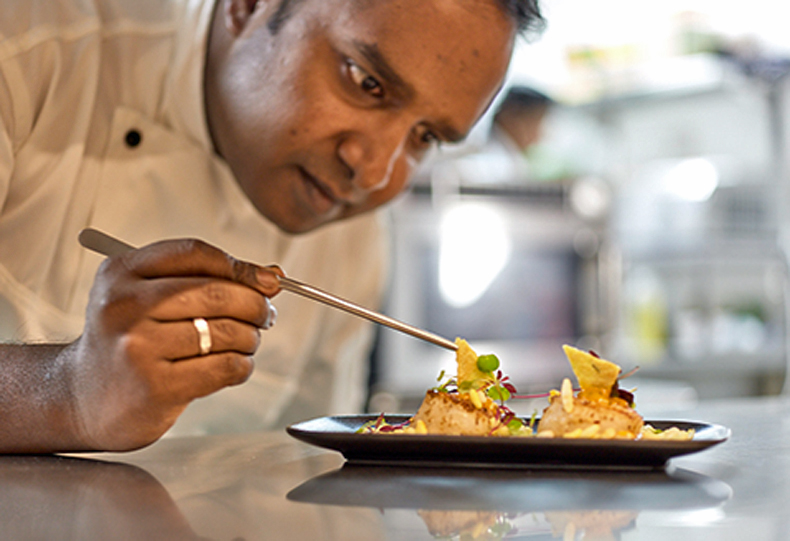
Peter Joseph held a Michelin star for six years as head chef of the original UK Indian Michelin starred restaurant Tamarind. A restaurant that has become something of an institution and while it continues to be based in Mayfair, Tamarind is now under new stewardship having reopened in 2019 after significant refurbishment and a change in culinary direction. This came about after Peter moved on at the end of 2018 to set up his own venture in the relative suburban idyll of Chelsea, with his own chic, high-end dining restaurant offering Kahani. The name Kahani means story in Hindi, which perhaps signals Peter’s intent to revisit his roots when writing his menus. To explore the link between past and present at the new restaurant, we must consider Peter’s background as well as his thoughts on the future needs of his local audience.
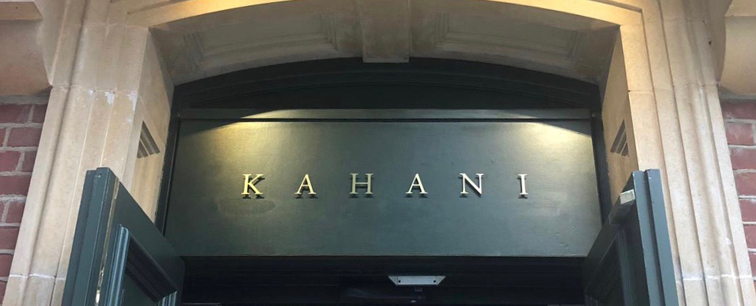
Peter grew up in Chennai, the capital of Tamil Nadu state in Southern India. They say that southern Indian cuisine has its roots in the secretly guarded recipes of private homes. Well, Peter’s early inspiration for cooking certainly came from observing his mother, indeed “my sibling and I would compete to get the last of the pot of our mother’s chicken or lamb curries,” fondly remembers Peter. Culturally at that time it was a man’s role to be an engineer, a doctor, a lawyer or an accountant but not a cook, nevertheless the young Peter was found borrowing ingredients from his mother’s kitchen to cook a dish with his friends as part of a social gathering around food. He was also in awe of the chefs he had seen on TV in their smart uniforms creating colourful and flavoursome food. So after schooling Peter enrolled at Hotel Management School on a three years course.
Peter’s first role thereafter was at Sheraton Group of International Hotels starting as a pastry chef, before becoming a sous chef at the hotel, this experience exposed Peter to a variety of international cuisines to match the international clientele of the hotel – from classical French to Malaysian, or from Chinese to regional Indian and so on. Peter’s executive chef, Rakesh Upadhya, proved an inspirational figure, teaching him the importance of channeled passion, such that he was able to plan accurately and be adaptable to new challenges. From 2004, after five years with the Sheraton Group, Peter moved to London and a hotel at London Bridge. Peter’s first understanding of the rigours of a Michelin starred restaurant came two years later when he joined Tamarind as a sous chef. This was a challenging time, as through all his previous experiences, he had not encountered anything like the demands of this type of cooking – the expectations, the challenges, the consistency required. By 2012, Peter had earned his stripes delivering the right taste and texture service in, service out and was rewarded with the head chef role at Tamarind, holding the Michelin star in his own right continuously until his departure at the end of 2018. Peter was ready for a new opportunity and challenge, so his own restaurant, Kahani was conceived.
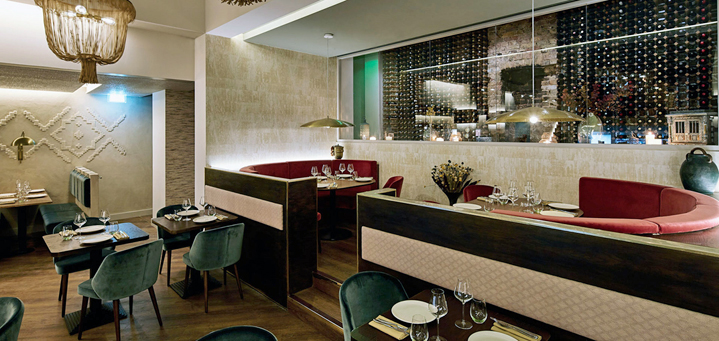
[Kahani restaurant interior with impressive glass walled wine cellar which is home to some beautiful wines and vintages]
The concept at Kahani was to be different from Tamarind, a move away from traditional curries and spices, to develop his own personal cooking signature and identity. Part of this would involve taking the spices of traditional sauces and making powders to effectively lift and flavour enhance through seasoning a dish. This would replace the need for a heavy or overwhelming sauce applied to ingredients that at Kahani might be prepared on the robata grill or in the tandoor. The sauces to food, where such apply, are made far lighter than the traditional recipes that we might associate with Indian restaurants. This, no doubt, will appeal to the modern British audience and to those of Chelsea and Belgravia particularly. The theme is also of sharing, like Peter once did in the quintessential Indian practice of young friends cooking and sharing a meal – a real social occasion to his diners at Kahani.
So now for the chef to analyze three of his signature dishes against those Michelin criteria. These will be the Broccoli, Prawn and Butter Chicken based dishes found on the a la carte menu.

[The Kahani broccoli dish is one of the customer favourites and a dish Peter is proud to have created]
Peter believes that there is a window for getting cooking techniques right and that window applies to cooking time, method and seasoning. For example, should you over boil broccoli it will lose its texture, colour and flavour. Likewise cook broccoli too long in the tandoor it will become burnt, crisp and bitter. So essentially there is a direct correlation between cooking technique and consistency, so both are fundamentals and basics that must be got right. There is also a link to consistency from provenance. Overall consistency checks and balances are achieved through knowing the recipes clearly, practice, calm but clear communication, tasting, ensuring constant quality of ingredients and training. Peter continuously conducts this orchestra of taste in his kitchen and instills the right values in his team. To enhance both flavour and texture of the broccoli, Peter’s technique is to coat with roasted lentil flour. Balance and harmony is achieved through marination using honey, combined with nigella seeds and wheat crisps for texture. The finishing touch that lifts the tandoor dish to dizzy heights is a tamarind infused yoghurt garnish.
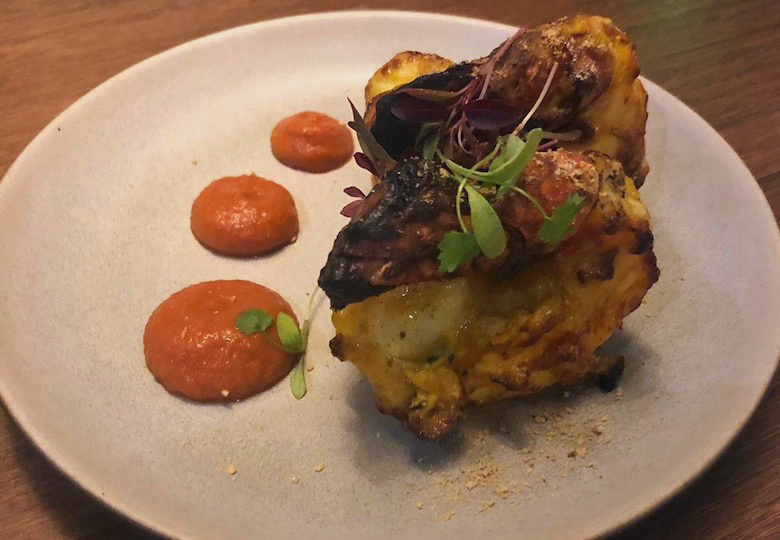
[Kahani King Prawns impress with complementing sweet and sour notes]
Exceptional Indonesian prawns are selected for the next dish. These were found to maintain a sweet meaty texture, avoiding the smaller, mushier textured products that might populate lesser menus. The dish leans on Malabar cuisine – south west Indian coastal origins – but instead of a wet curry sauce, here Peter makes a powder from coconut, green chilli, curry leaves and ginger and cooks the prawns in a tandoor to avoid heaviness or grease. A smoked tomato chutney is served as a garnish to cut through the natural sweetness of the crustacean and the marinade.
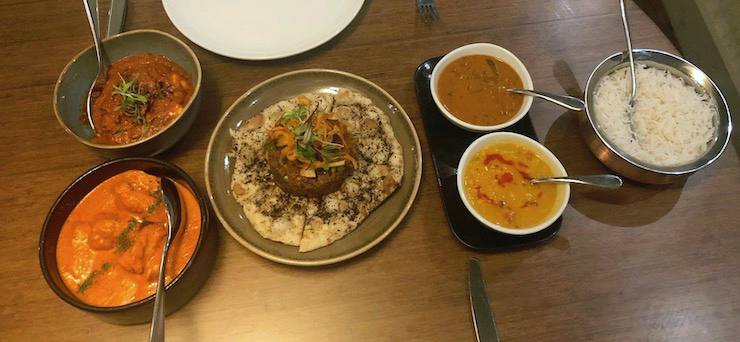
[Bottom left: Kahani Butter Chicken has a lightness of touch that is so appealing to modern tastes]
The Kahani butter chicken is a signature because it is lower on cream and butter compared to more traditional makhani recipes. Garam masalas from India are used in the traditional way, there is no compromise on flavour with finest quality herb-fed chicken, which is chargrilled. The consistency of the chicken supplied is a key objective of Peter’s with this flavoursome dish that exudes a lightness of touch.
Overall the menu at Kahani is impressive and Peter’s thinking about appealing to the more residential audience of Chelsea, who may have particular tastes, has struck a winning formula, with a refreshing new perspective on traditional Indian cuisine. There’s a lot more to this restaurant than the phrase ‘modern twist’ might evoke. The front of



